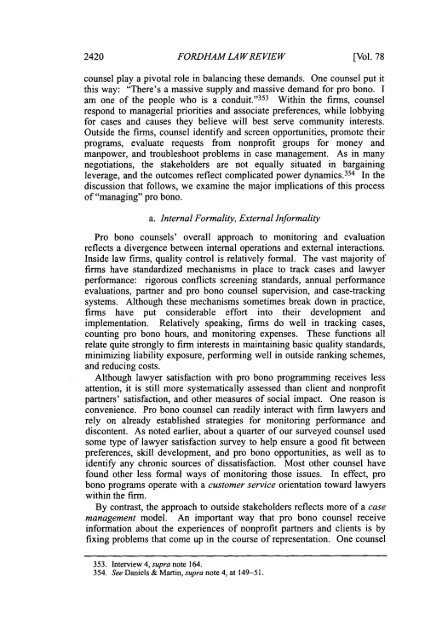Law for The Poor
Law for The Poor
Law for The Poor
You also want an ePaper? Increase the reach of your titles
YUMPU automatically turns print PDFs into web optimized ePapers that Google loves.
2420 FORDHAM LAWREVIEW<br />
[Vol. 78<br />
counsel play a pivotal role in balancing these demands. One counsel put it<br />
this way: "<strong>The</strong>re's a massive supply and massive demand <strong>for</strong> pro bono. I<br />
am one of the people who is a conduit. '353 Within the firms, counsel<br />
respond to managerial priorities and associate preferences, while lobbying<br />
<strong>for</strong> cases and causes they believe will best serve community interests.<br />
Outside the firms, counsel identify and screen opportunities, promote their<br />
programs, evaluate requests from nonprofit groups <strong>for</strong> money and<br />
manpower, and troubleshoot problems in case management. As in many<br />
negotiations, the stakeholders are not equally situated in bargaining<br />
leverage, and the outcomes reflect complicated power dynamics. 354 In the<br />
discussion that follows, we examine the major implications of this process<br />
of "managing" pro bono.<br />
a. Internal Formality, External In<strong>for</strong>mality<br />
Pro bono counsels' overall approach to monitoring and evaluation<br />
reflects a divergence between internal operations and external interactions.<br />
Inside law firms, quality control is relatively <strong>for</strong>mal. <strong>The</strong> vast majority of<br />
firms have standardized mechanisms in place to track cases and lawyer<br />
per<strong>for</strong>mance: rigorous conflicts screening standards, annual per<strong>for</strong>mance<br />
evaluations, partner and pro bono counsel supervision, and case-tracking<br />
systems. Although these mechanisms sometimes break down in practice,<br />
firms have put considerable ef<strong>for</strong>t into their development and<br />
implementation. Relatively speaking, firms do well in tracking cases,<br />
counting pro bono hours, and monitoring expenses. <strong>The</strong>se functions all<br />
relate quite strongly to firm interests in maintaining basic quality standards,<br />
minimizing liability exposure, per<strong>for</strong>ming well in outside ranking schemes,<br />
and reducing costs.<br />
Although lawyer satisfaction with pro bono programming receives less<br />
attention, it is still more systematically assessed than client and nonprofit<br />
partners' satisfaction, and other measures of social impact. One reason is<br />
convenience. Pro bono counsel can readily interact with firm lawyers and<br />
rely on already established strategies <strong>for</strong> monitoring per<strong>for</strong>mance and<br />
discontent. As noted earlier, about a quarter of our surveyed counsel used<br />
some type of lawyer satisfaction survey to help ensure a good fit between<br />
preferences, skill development, and pro bono opportunities, as well as to<br />
identify any chronic sources of dissatisfaction. Most other counsel have<br />
found other less <strong>for</strong>mal ways of monitoring those issues. In effect, pro<br />
bono programs operate with a customer service orientation toward lawyers<br />
within the firm.<br />
By contrast, the approach to outside stakeholders reflects more of a case<br />
management model. An important way that pro bono counsel receive<br />
in<strong>for</strong>mation about the experiences of nonprofit partners and clients is by<br />
fixing problems that come up in the course of representation. One counsel<br />
353. Interview 4, supra note 164.<br />
354. See Daniels & Martin, supra note 4, at 149-51.

















